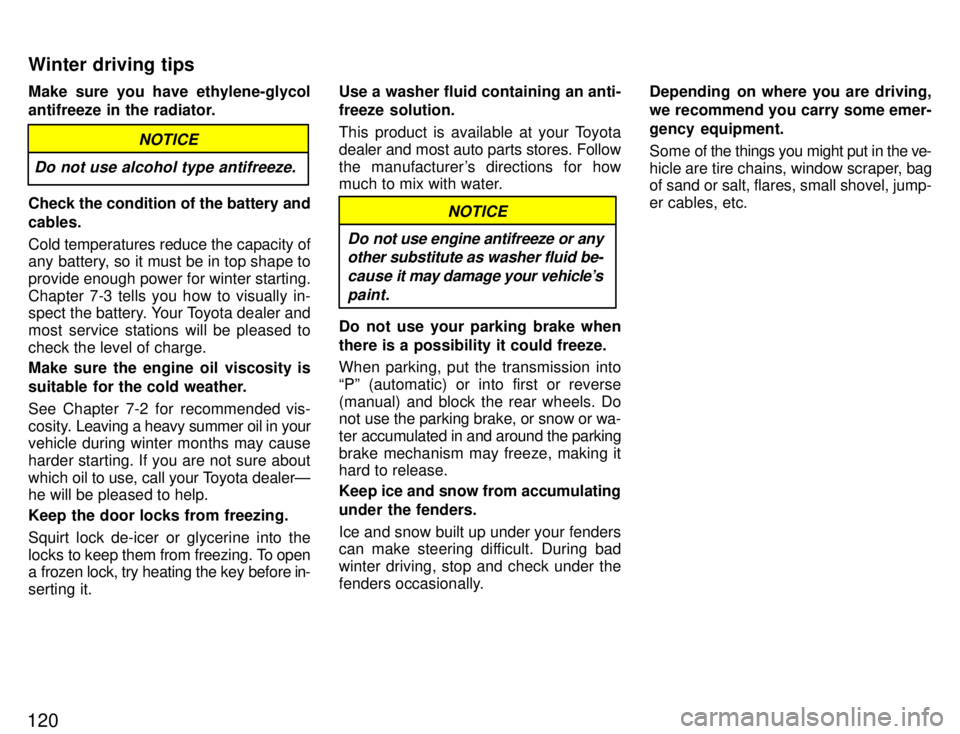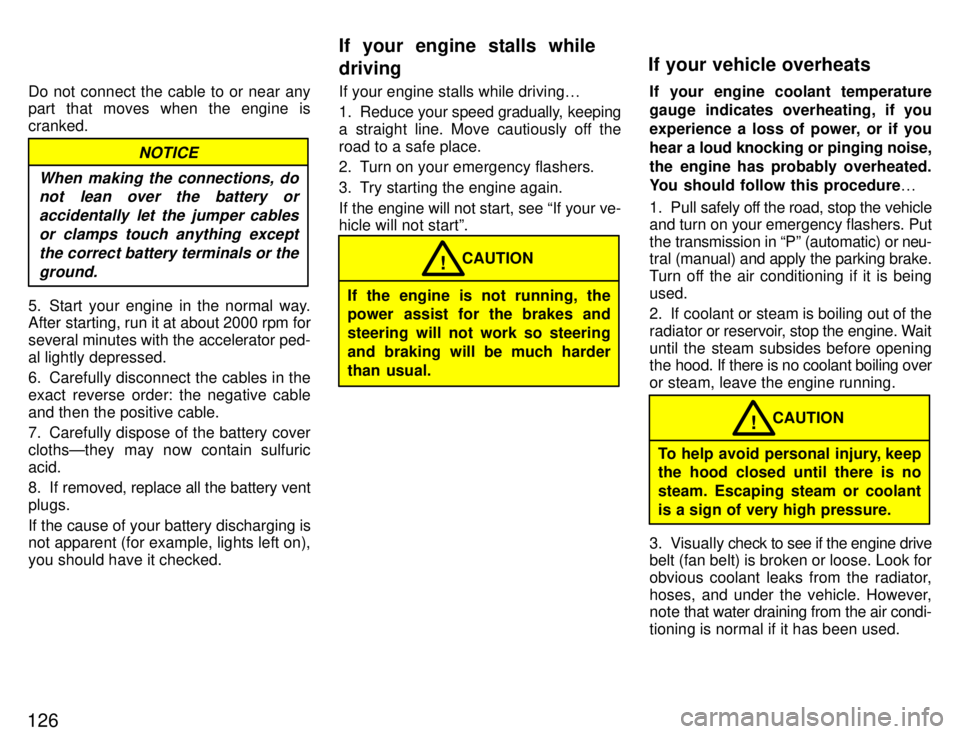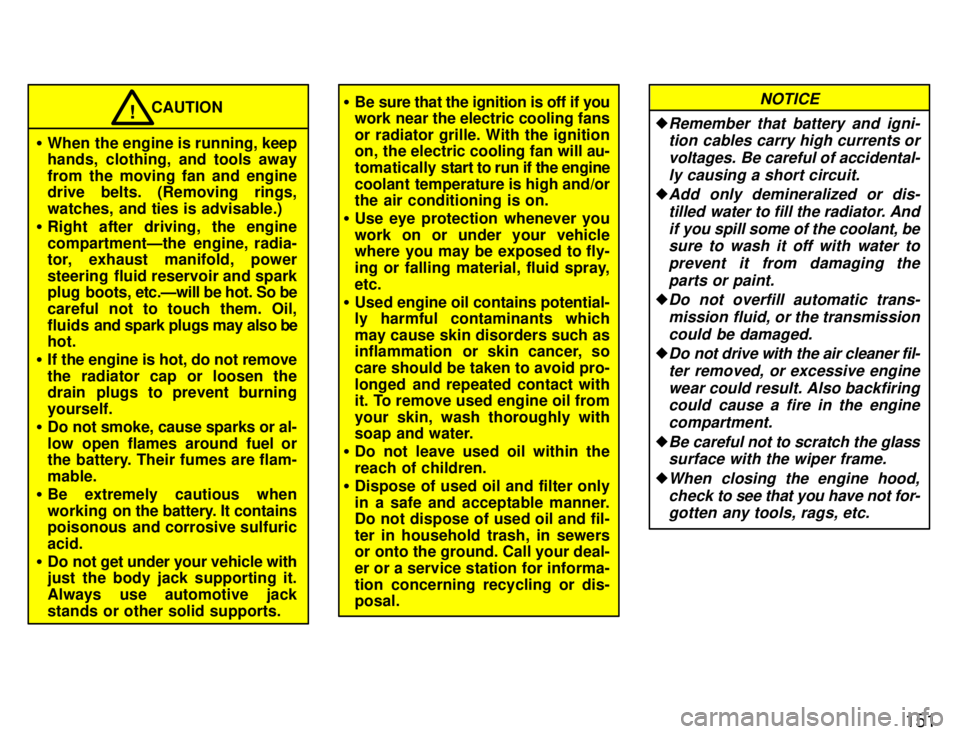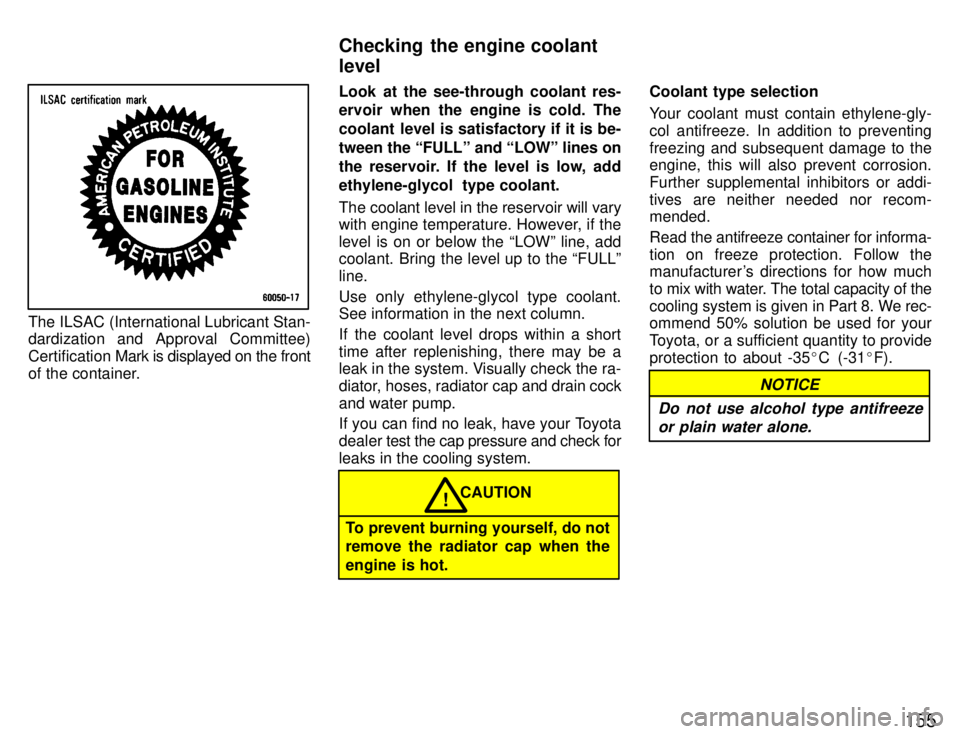1996 TOYOTA SUPRA radiator
[x] Cancel search: radiatorPage 122 of 188

120Make sure you have ethylene-glycol
antifreeze in the radiator.
Do not use alcohol type antifreeze.
NOTICE
Check the condition of the battery and cables. Cold temperatures reduce the capacity of
any battery, so it must be in top shape to provide enough power for winter starting.Chapter 7-3 tells you how to visually in-
spect the battery. Your Toyota dealer and
most service stations will be pleased tocheck the level of charge.
Make sure the engine oil viscosity is
suitable for the cold weather.
See Chapter 7-2 for recommended vis-
cosity.
Leaving a heavy summer oil in your
vehicle during winter months may cause
harder starting. If you are not sure about
which oil to use, call your Toyota dealerÐ
he will be pleased to help. Keep the door locks from freezing. Squirt lock de-icer or glycerine into the
locks to keep them from freezing. To open
a frozen lock, try heating the key before in-serting it. Use a washer fluid containing an anti-
freeze solution.
This product is available at your Toyota
dealer and most auto parts stores. Follow
the manufacturer's directions for how
much to mix with water.NOTICE
Do not use engine antifreeze or any other substitute as washer fluid be-
cause it may damage your vehicle's
paint.
Do not use your parking brake when there is a possibility it could freeze. When parking, put the transmission into
Pº (automatic) or into first or reverse
(manual) and block the rear wheels. Do
not use the parking brake, or snow or wa-
ter accumulated in and around the parkingbrake mechanism may freeze, making it
hard to release. Keep ice and snow from accumulating
under the fenders.
Ice and snow built up under your fenders
can make steering difficult. During bad winter driving, stop and check under the
fenders occasionally. Depending on where you are driving,
we recommend you carry some emer- gency equipment.
Some of
the things you might put in the ve-
hicle are tire chains, window scraper, bag of sand or salt, flares, small shovel, jump- er cables, etc.
Winter driving tips
Page 128 of 188

126Do not connect the cable to or near any
part that moves when the engine is cranked.
NOTICE
When making the connections, do not lean over the battery or
accidentally let the jumper cables or clamps touch anything exceptthe correct battery terminals or the ground.
5. Start your engine in the normal way.
After starting, run it at about 2000 rpm for several minutes with the accelerator ped-
al lightly depressed.
6. Carefully disconnect the cables in the
exact reverse order: the negative cable
and then the positive cable.
7. Carefully dispose of the battery cover
clothsÐthey may now contain sulfuricacid.
8. If removed, replace all the battery vent plugs.
If the cause of your battery discharging is
not apparent (for example, lights left on), you should have it checked. If your engine stalls while driving
0
1. Reduce your speed gradually, keeping
a straight line. Move cautiously off the
road to a safe place.
2. Turn on your emergency flashers.
3. Try starting the engine again.
If the engine will not start, see If your ve-
hicle will not startº.If the engine is not running, the
power assist for the brakes and
steering will not work so steering
and braking will be much harder
than usual. CAUTION
! If your engine coolant temperature
gauge indicates overheating, if you
experience a loss of power, or if you
hear a
loud knocking or pinging noise,
the engine has probably overheated.
You should follow this procedure 0
1. Pull safely off the road, stop the vehicle
and turn on your emergency flashers. Put
the transmission in Pº (automatic) or neu-
tral ( manual) and apply the parking brake.
Turn off the air conditioning if it is beingused.
2. If coolant or steam is boiling out of the
radiator or reservoir, stop the engine. Wait
until the steam subsides before opening
the hood. If there is no coolant boiling over or steam, leave the engine running.
To help avoid personal injury, keep
the hood closed until there is no steam. Escaping steam or coolant
is a sign of very high pressure. CAUTION
!
3. Visually check to see if the engine drive
belt (fan belt) is broken or loose. Look for
obvious coolant leaks from the radiator,
hoses, and under the vehicle. However, note that water draining from the air condi-
tioning is normal if it has been used.
If your vehicle overheats
If your engine stalls while driving
Page 153 of 188

151
�When the engine is running, keep
hands, clothing, and tools away
from the moving fan and engine
drive belts. (Removing rings,
watches, and ties is advisable.)
� Right after driving, the engine
compartmentÐthe engine, radia-
tor, exhaust manifold, power
steering fluid reservoir and spark
plug boots, etc.Ðwill be hot. So be
careful not to touch them. Oil,
fluids and spark plugs may also be
hot.
� If the engine is hot, do not remove
the radiator cap or loosen the
drain plugs to prevent burning yourself.
� Do not smoke, cause sparks or al-
low open flames around fuel or
the battery. Their fumes are flam- mable.
� Be extremely cautious when
working on the battery. It contains
poisonous and corrosive sulfuricacid.
� Do not get under your vehicle with
just the body jack supporting it.
Always use automotive jack
stands or other solid supports. CAUTION
!�
Be sure that the ignition is off if you
work near the electric cooling fans
or radiator grille. With the ignition
on, the electric cooling fan will au-
tomatically start to run if the engine
coolant temperature is high and/or
the air conditioning is on.
� Use eye protection whenever you
work on or under your vehicle
where you may be exposed to fly-
ing or falling material, fluid spray,etc.
� Used engine oil contains potential-
ly harmful contaminants which
may cause skin disorders such as
inflammation or skin cancer, so
care should be taken to avoid pro-
longed and repeated contact with
it. To remove used engine oil from
your skin, wash thoroughly with
soap and water.
� Do not leave used oil within the reach of children.
� Dispose of used oil and filter only
in a safe and acceptable manner.
Do not dispose of used oil and fil-
ter in household trash, in sewers
or onto the ground. Call your deal-
er or a service station for informa-
tion concerning recycling or dis- posal. �
Remember that battery and igni-
tion cables carry high currents or
voltages. Be careful of accidental-
ly causing a short circuit.
�Add only demineralized or dis-tilled water to fill the radiator. And
if you spill some of the coolant, besure to wash it off with water to
prevent it from damaging the
parts or paint.
�Do not overfill automatic trans-mission fluid, or the transmission
could be damaged.
�Do not drive with the air cleaner fil-ter removed, or excessive enginewear could result. Also backfiringcould cause a fire in the engine
compartment.
�Be careful not to scratch the glasssurface with the wiper frame.
�When closing the engine hood,
check to see that you have not for-
gotten any tools, rags, etc.
NOTICE
Page 157 of 188

155
The ILSAC (International Lubricant Stan-
dardization and Approval Committee) Certification Mark is displayed on the front
of the container. Look at the see-through coolant res-
ervoir when the engine is cold. The
coolant level is satisfactory if it is be-
tween the FULLº and LOWº lines on
the reservoir. If the level is low, add
ethylene-glycol type coolant.
The coolant level in the reservoir will vary
with engine temperature. However, if the
level is on or below the LOWº line, add
coolant. Bring the level up to the FULLº line. Use only ethylene-glycol type coolant. See information in the next column.
If the coolant level drops within a short
time after replenishing, there may be a
leak in the system. Visually check the ra-
diator, hoses, radiator cap
and drain cock
and water pump.
If you can find no leak, have your Toyota
dealer test the cap pressure and check for
leaks in the cooling system.
To prevent burning yourself, do not remove the radiator cap when the
engine is hot.
CAUTION! Coolant type selection
Your coolant must contain ethylene-gly-
col antifreeze. In addition to preventingfreezing and subsequent damage to the
engine, this will also prevent corrosion. Further supplemental inhibitors or addi-
tives are neither needed nor recom- mended.
Read
the antifreeze container for informa-
tion on freeze protection. Follow the
manufacturer 's directions for how much
to mix with water. The total capacity of the
cooling system is given in Part 8. We rec- ommend 50% solution be used for your
Toyota, or a sufficient quantity to provideprotection to about -35 �C (-31 �F).
Do not use alcohol type antifreeze
or plain water alone.
NOTICE
Checking the engine coolant level